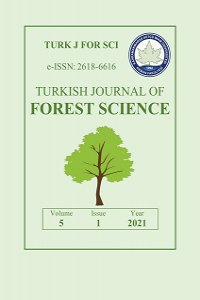BAZI KAVAK (POPULUS L.) TAKSONLARININ KADMIYUMA KARŞI FITOEKSTRAKSIYON ROLLERI
Bitki ıslahı, Ağır metal, Kadmiyum, Kavak klonları, AAS
PHYTOEXTRACTION ROLES OF SOME POPLAR (POPULUS L.) TAXA AGAINST TO CADMIUM
Plant breeding, Heavy metal, Cadmium, Poplar clones, AAS,
___
- Aybar, M., Bilgin, A., Sağlam, B., (2015). Fitoremediasyon Yöntemi İle Topraktaki Ağır Metallerin Giderimi, Doğal Afetler ve Çevre Dergisi, 1 (1-2) 59-65.
- Baccioa, D., Castagna, A., Tognetti, R., Ranieri, A., Sebastiani, L. (2014). Early responses to cadmium of two poplar clones that differ in stress tolerance. Journal of Plant Physiology, 171, 1693–1705.
- Benavides, M. P., Gallego, S. M. (2005). Tomaro, M. L.. Cadmium Toxicity in Plants. Brazil Journal Plant Physiology, Vol.17 No.1, Londrina, 21-34.
- Castiglione, S., Todeschini, V., Franchin, C., Torrigiani, P., Gastaldi, D., Cicatelli, A., Rinaudo, C., Berta, G., Biondi, S., Lingua, G. (2009). Clonal differences in survival capacity, copper and zinc accumulation, and correlation with leaf polyamine levels in poplar: A large-scale field trial on heavily polluted soil, Environ Pollut., 157:2108–2117.
- Clemens, S. (2001). Molecular mechanisms of plant metal tolerance and homeostasis. Planta, 212:475-486 doi:10.1007/s004250000458.
- Clemens, S., Palmgren, M.G. & Krämer, U. (2002). A long way ahead: understanding and engineering plant metal accumulation. Trends in Plant Science, 7, 309-315.
- Dai, Hui-Ping., Chan-Juan , Shan., Genliang, Jia., Chao, Lu., Tu-Xi Yang and An-Zhi Wei. (2013). Cadmium detoxification in Populus×canescens. Turkish Journal of Botany, 37: 950-955.
- Di Lonardo, S., Capuana, M., Arnetoli, M., Gabbrielli, R., Gonnelli, C. (2011). Exploring the metal phytoremediation potential of three Populus alba L. clones using an in vitro screening. Environ Sci Pollut Res., 18:82–90.
- Elobeid, M., Göbel, C., Feussner, I., Polle, A. (2012). Cadmium interferes with auxin physiology and lignification in poplar. J Exp Bot., doi :10.1093/jxb/err384.
- Hall, J. L. (2002). Cellular mechanisms for heavy metal detoxification and tolerance. Journal of Experimental Botany, 53, 1-11.
- Hamutoğlu, R., Dinçsoy, A.B., Cansaran-Duman, D., Aras, S., (2012). Biyosorpsiyon, adsorpsiyon ve fitoremediasyon yöntemleri ve uygulamaları, Türk Hijyen ve Deneysel Biyoloji Dergisi, 69(4): 235-53.
- He, J., Li, H., Luo, J., Ma, C., Li, S., Qu, L., Gai, Y., Jiang, X., Janz, D., Polle, A., Tyree, M., Luo Z. (2013). A Transcriptomic Network Underlies Microstructural and Physiological Responses to Cadmium in Populus canescens L. Plant Physiology, Vol. 162, pp. 424–439.
- He, J., Qin, J., Long, L., Ma, Y., Li, H., Li, K., Jiang, X., Liu, T., Polle, A., Liang, Z., Luo, Z. B. (2011). Net cadmium flux and accumulation reveal tissue-specific oxidative stress and detoxification in Populus×canescens. Physiol Plant 143:50–63.
- Jakovljevic, T., Bubalo, M. C., Orlovic, S., Sedak M., Bilandzic, N., Brozincevic, I., Redovnikovic IR. (2014). Adaptive response of poplar (Populus nigra L.) after prolonged Cd exposure period. Environmental science and pollution research international, 21:3792-3802 doi:10.1007/s11356-013-2292-7.
- Kramer, U. (2010). Metal hyperaccumulation in plants. Annu Rev Plant Biol, 61:517–534.
- Laureysens, I., De Temmerman, L., Hastir, T., Van Gysel, M., Ceulemans, R. (2005). Clonal variation in heavy metal accumulation and biomass production in a poplar coppice culture, II. Vertical distribution and phytoextraction potential, Environ Pollut., 133:541–551.
- Marmiroli, M., Imperiale, D., Maestri, E., Marmiroli, N. (2013). The response of Populus spp. to cadmium stress: Chemical, morphological and proteomics study. Chemosphere, 93:1333-1344.
- Padmavathiamma PK, Loretta YL. (2007). Phytoremediation technology: Hyper-accumulation metals in plants. Water Air Soil Pollut, 184: 105-26.
- Pietrini, F., Zacchini, M., Iori, V., Pietrosanti, L., Bianconi, D., Massacci, A. (2010). Screening of poplar clones for cadmium phytoremediation using photosynthesis, biomass and cadmium content analyses, Int J Phytoremediat 12:105–120. Plant Physiology Preview. DOI:10.1104/pp.110.164152.
- Pivetz, B. E. (2001). Phytoremediation of contaminated soil and ground water at hazardous waste sites, United States Environmental Protection Agency EPA, 540/S-01/500, 36 p.
- Schulze, E., Beck, E., Müller-Hohenstein, K. (2005). Plant Ecology. Springer, Germany, Berlin, 702p.
- Shacklette, H. T. (1972). Cadmium in plants. U.S. Geological Survey Bull. 1314-G.
- Twyman, R. M. (2005). Sample Dissolution for Elemental Analysis/Wet Digestion. pp: 4503-4510, University York, UK.
- Vanlı, Ö. (2007). Pb, Cd, B Elementlerinin Topraklardan Şelat Destekli Fitoremediasyon Yöntemiyle Giderilmesi, İ.T.Ü Fen Bilimleri Enstitüsü, Çevre Mühendisliği Anabilim Dalı, 88 s. İstanbul.
- Velioğlu, E., Akgül, S., (2016). Poplars and Willows in Turkey: Country Progress Report of the National Poplar Commision. Time period: 2012-2015, Poplar and Fast Growing Forest Trees Research Institute, 20. S, İzmit/Turkey.
- White, P. J. ve Brown, P. H. (2010). Plant nutrition for sustainable development and global health. Annals of Botany, 105, 1073-1080.
- Yayın Aralığı: Yılda 2 Sayı
- Başlangıç: 2017
- Yayıncı: Kahramanmaraş Sütçü İmam Üniversitesi
BAZI KAVAK (POPULUS L.) TAKSONLARININ KADMIYUMA KARŞI FITOEKSTRAKSIYON ROLLERI
Esra Nurten YER ÇELİK, Sezgin AYAN, Mehmet Cengiz BALOĞLU
KÜLTÜREL MİRAS ÖRNEKLERİNİN YERSEL FOTOGRAMETRİ YÖNTEMLERLE KAYIT ALTINA ALINMA IMKANLARININ ANALİZİ
Ebru BİLİCİ, Zennure UÇAR, Abdullah Emin AKAY, Musa GENÇ
DÜŞÜK MALİYETLİ İNSANSIZ HAVA ARAÇLARI İÇİN UÇUŞ ÖNCESİ BLOK PLANLAMANIN DEĞERLENDİRİLMESİ
Sercan GÜLCİ, Hüseyin YURTSEVEN, Mustafa AKGÜL
Mehmet PAK, Osman AKÇAY, Arif OKUMUŞ
EKOLOJİK YIKIMIN VE SALGINLARIN ARDINDAKİ GERÇEK; EKOSİSTEMİK YABANCILAŞMA MI?
TÜRKİYE’DE İTHAL ODUN HAMMADDESİYLE İLİŞKİLİ ORMAN ENDÜSTRİ İŞLETMELERİNİN GENEL YAPISI
Musa AKKAYA, Kenan OK, Mehtap KOÇ, İbrahim AKSEKİ, Mehmet Emin AKKAŞ
RAPIDEYE UYDU GÖRÜNTÜSÜ İLE PİKSEL TABANLI VE OBJE TABANLI SINIFLANDIRMALARIN KARŞILAŞTIRILMASI
Ebru ERSOY TONYALOĞLU, Nurdan ERDOGAN, Betül ÇAVDAR, Kübra KURTŞAN, Engin NURLU
